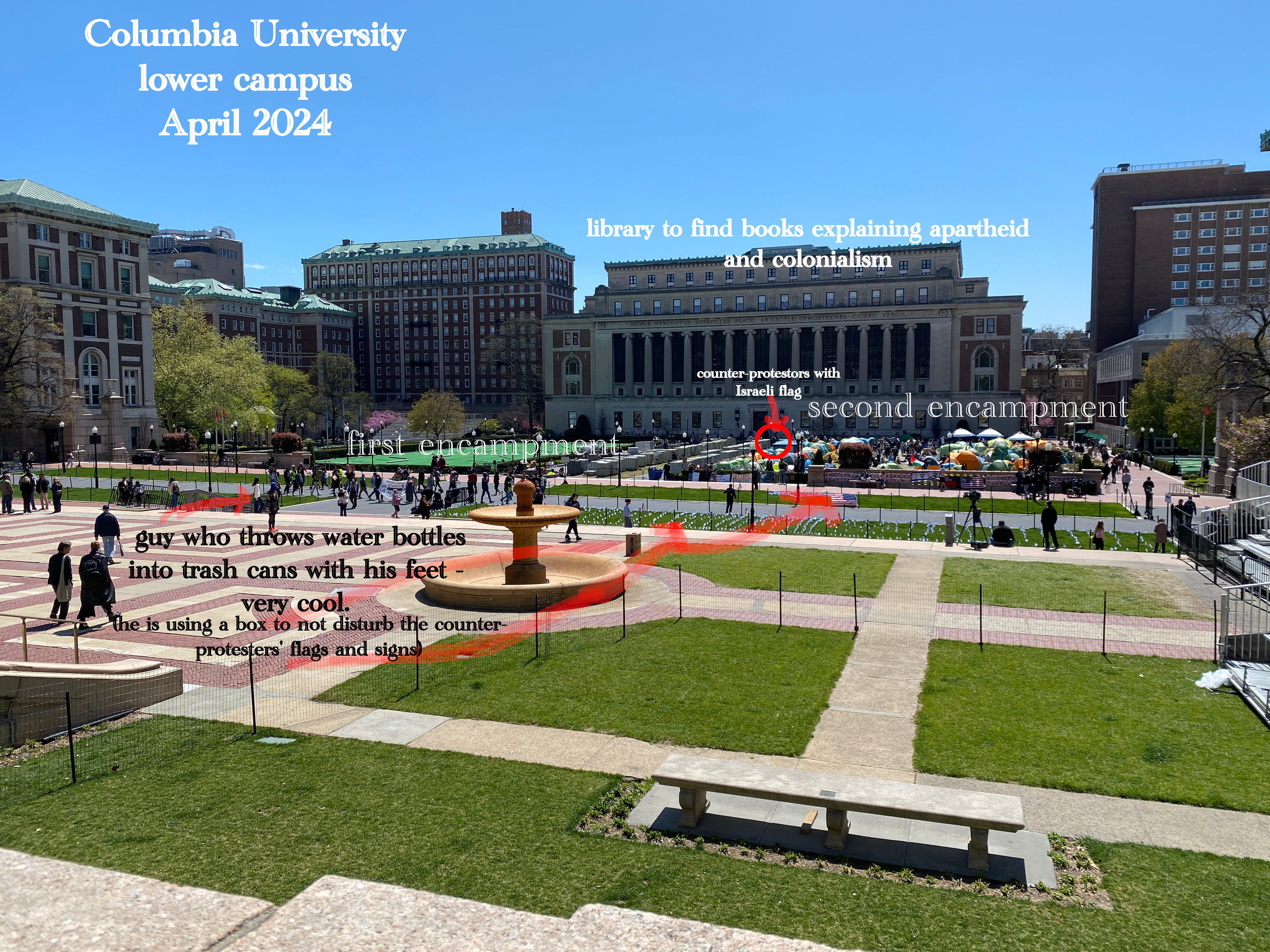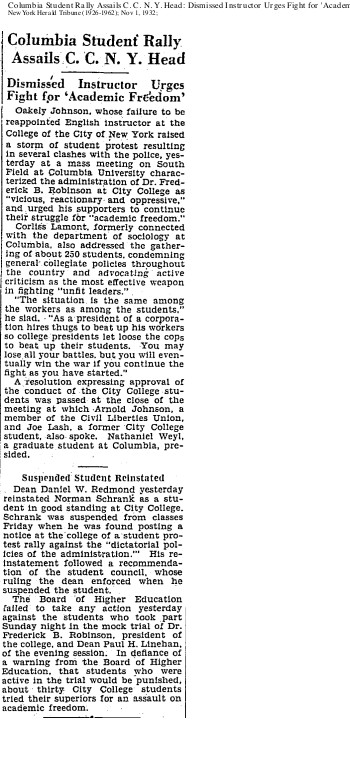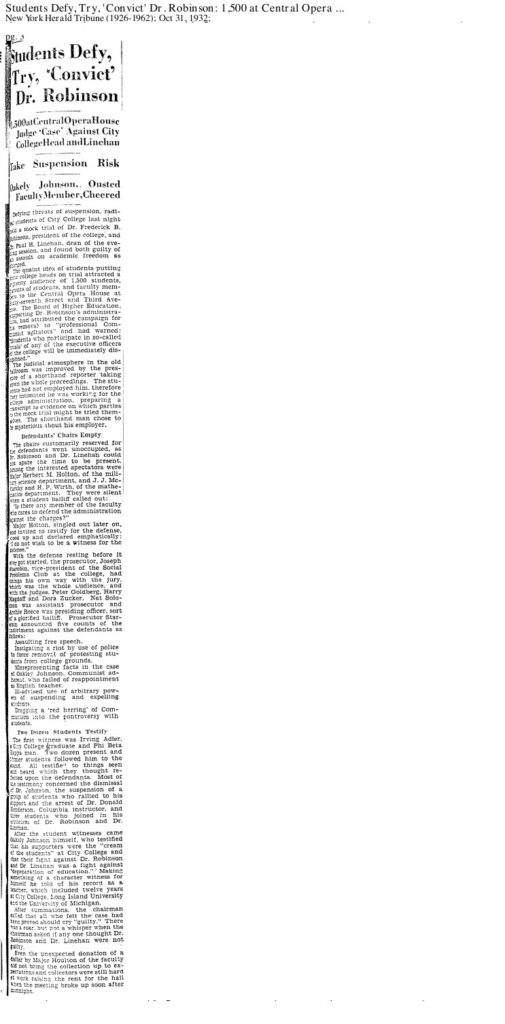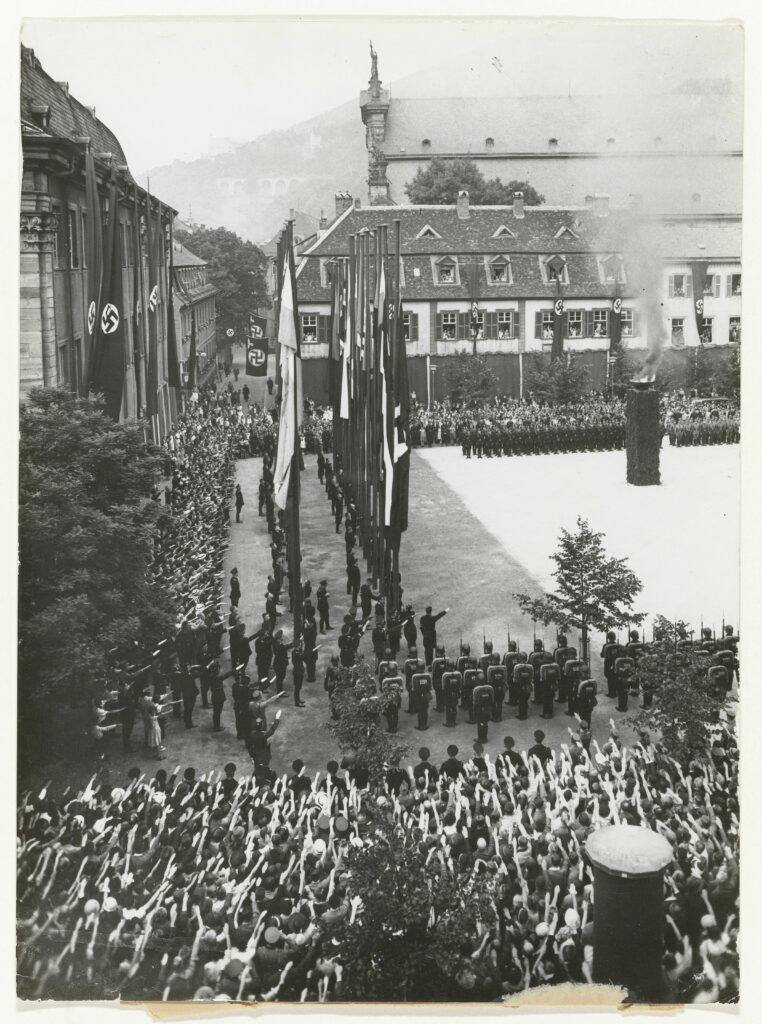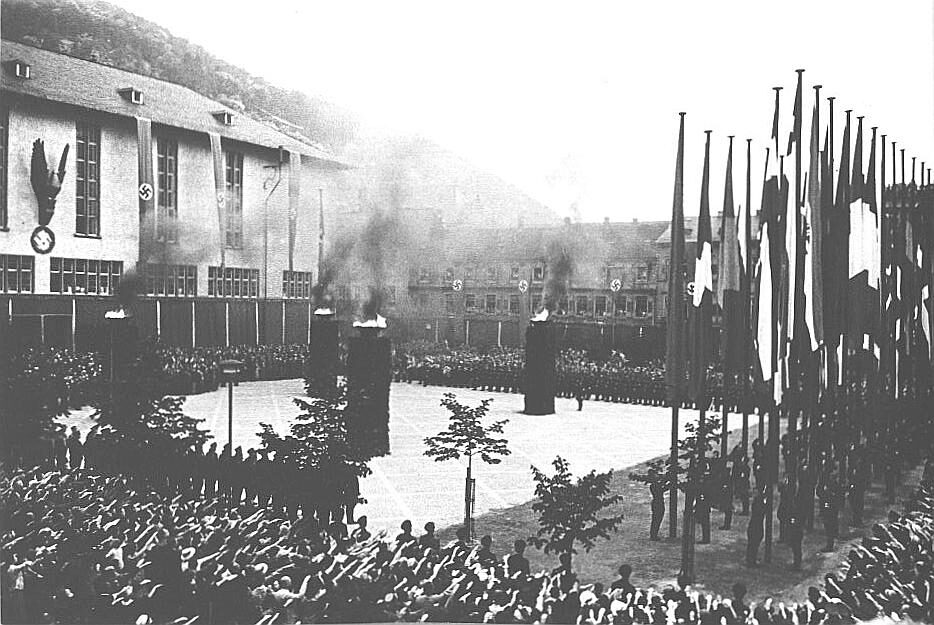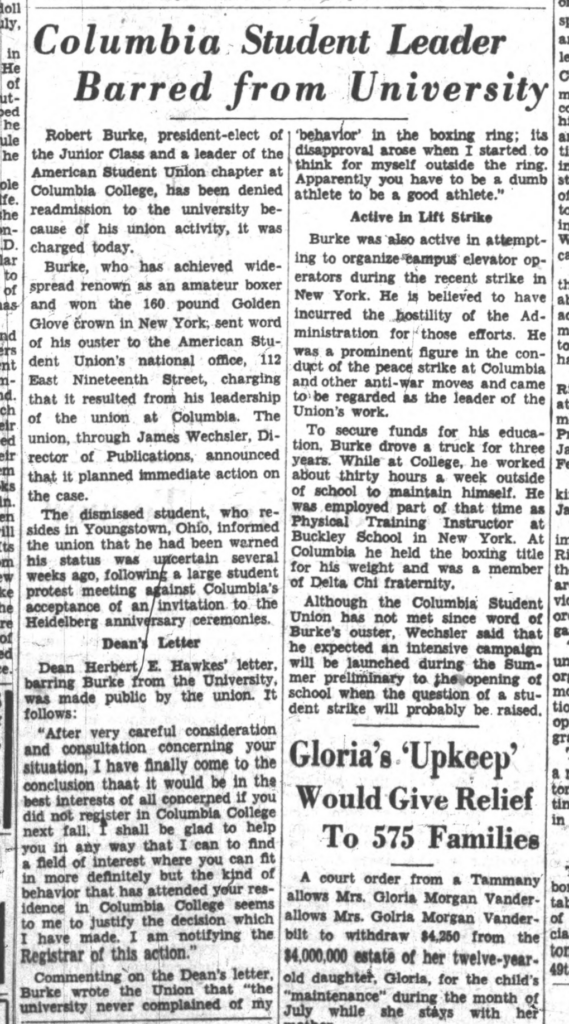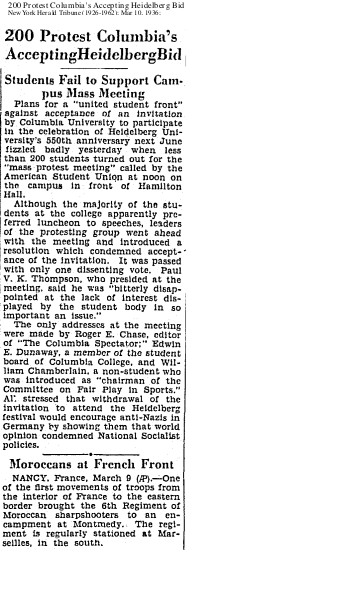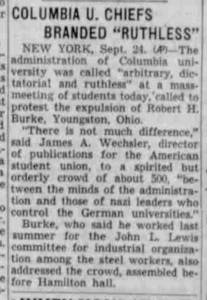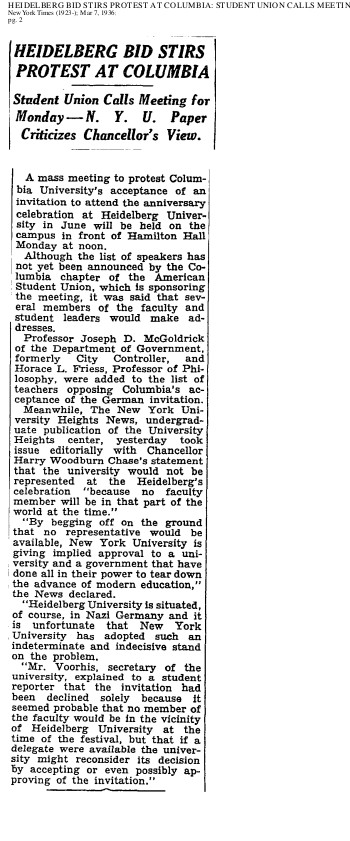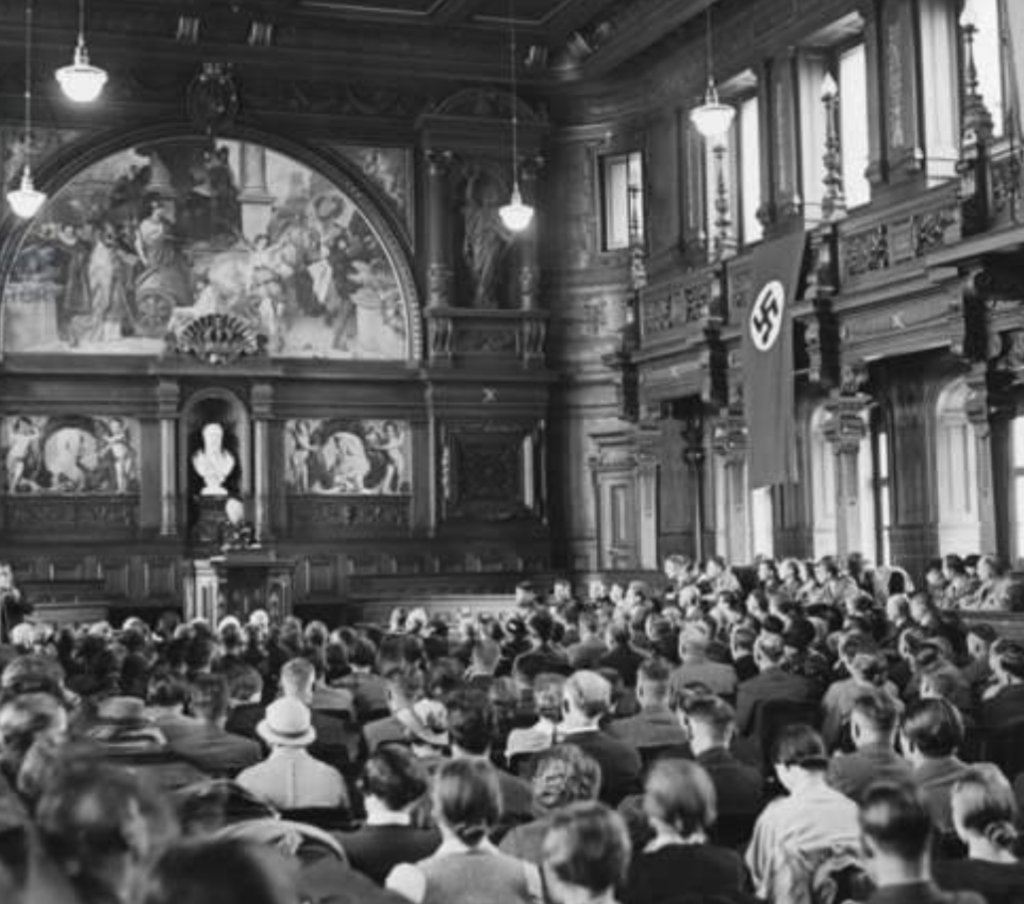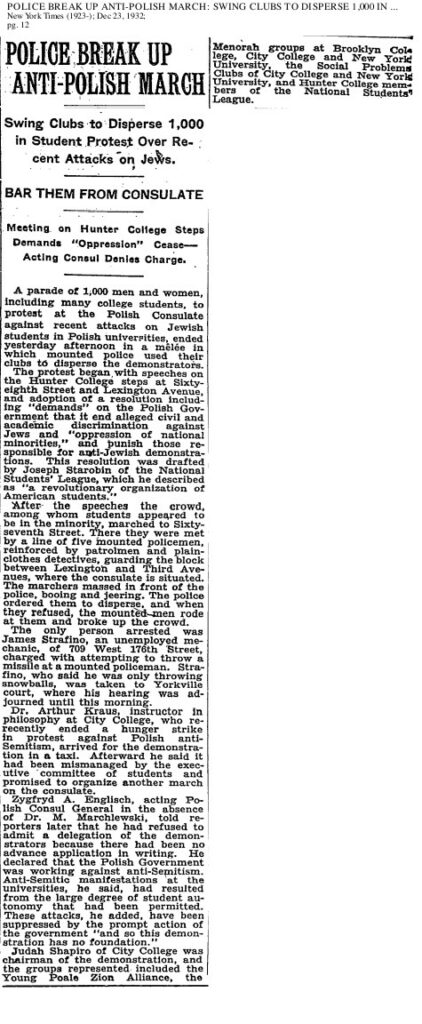In 1932 City College New York caused student protests by dismissing a popular instructor, Oakely Johnson. After four students were arrested, 1,000 students “marched to the court and staged another demonstration outside.” The judge closed the court, “and sent sixteen policemen … to disperse the mob.” Then “the students crossed the street, formed in squads and marched back and forth shouting demands for the release of their comrades.” The judge ordered out for more police, who arrested 16 students, and “the others dispersed.”
Johnson was then invited to speak at Columbia by students, along with Corliss Lamont (of the Lamont-Doherty Earth Observatory of Columbia University family).
Lamont’s speech on the occasion stated:
“The situation is the same among the workers as among the students. As a president of a corporation hires thugs to beat up his workers so college presidents let loose the cops to beat up their students.”
“Defying threats of suspension,” students held a trial of City College President Frederick B. Robinson, and “dean of the evening session” Paul H. Linehan. The students “found both guilty of an assault on academic freedom as charged.” The trial “attracted a capacity audience of 1,500 students, parents of students, and faculty members.”
True to form, The Board of Higher Education “attributed the campaign for … removal to ‘professional Communist agitators.'”
In 1936 Columbia suspended student Robert Burke “because of his union activity,” including “a large student protest meeting against Columbia’s acceptance of an invitation to the Heidelberg anniversary ceremonies” in Nazi Germany celebrating the 550th Anniversary of Heidelberg University, an event the New York Times would describe with the opening sentence:
“Heidelberg is draped with Nazi flags.”
These ceremonies were boycotted by England, and Oxford and Cambridge universities. “America, on the other hand, had by far the largest delegation of any foreign country, with twenty universities and colleges represented.” See below, “Nazi Troops March In Heidelberg Fete.”
Students wanted Columbia to cancel their attendance, emphasizing “that withdrawal of the invitation would encourage anti-Nazis in Germany by showing them that world opinion condemned National Socialist policies.” The Student Board of Columbia College voted 4-3 to pass a motion condeming Columbia’s participation.
A protest was held in front of Hinds Hall (formerly Hamilton Hall) where in 2024 police would throw peacefully protesting students down the steps and worse.
One student supporter was quoted in the papers as saying,
“There is not much difference between the minds of the administration and those of nazi leaders who control the German universities.”
The staffs of student paper The Spectator, as well as The Teacher’s College News, rebuked Columbia, the New York Herald Tribune reporting,
“When members of the staff of ‘The Spectator’ were unable to reach Dr. Nicholas Murray Butler, president of the university, who is aboard the S. S. Virginia near Panama [on a cruise], by ship to shore radio telephone, Roger E. Chase, editor of the publication dispated the following wireless message:
‘Saturday newspapers announced Columbia’s acceptance Heidelberg University invitation anniversary exercises. As editor “Spectator” I protest university action hope it will be rescinded please wire fifty word statement on matter immediately collect thanks Roger E. Chase.'”
In May, “almost 400” Columbia students held a “burning of books on South Field in burlesque of the destruction by University of Berlin students three years ago of books which did not comform with the Nazi ideology.” Burned books included “a work on peace by Dr. Butler” and a “mathematics textbook written by Dr. Herbert E. Hawkes, who is dean of Columbia College.”
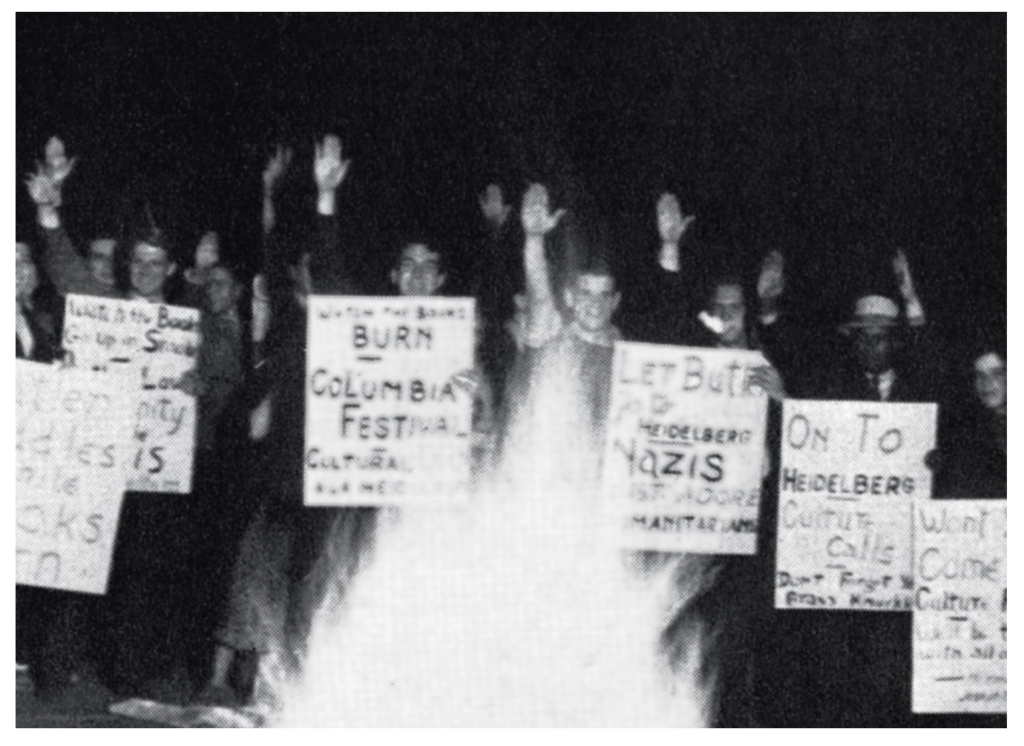
“South Field” was the where Columbia played footballs games 1915-1922 – and covers the area where both First Encampment and Second Encampment were held.
200 Columbia students marched to the home of Columbia President Dr. Nicholas Murray Butler at 60 Morningside Drive and “held a mass meeting at his doorstep to protest… They declared Dr. Butler elected to the Reichstag, attributed to him the support of William Randolph Hearst and left the vestibule of his house littered with placards proclaiming:
‘On to Heidelberg – Bring Your Brass Knuckles,’
‘On to Heidelberg – Culture Calls’
and
‘Nicholas Murray Butler Diddles While Books Burn.'”
Over 80 years before students chanted about the Columbia President, “Minouche Shafik, Go To Hell,” the 1936 students marched on their president’s house singing to the tune of “John Brown’s Body”:
‘Nicholas Murray Butler wants to go to Heidelberg…
But we say go to hell.'”
2 Columbia students stood on the steps of Butler’s home and led a chant with the other protesters:
“Who’s against war and Fascism?”
“We are.”
One of the consequences for Columbia was the loss of the school’s relationship with “Professor Frank Boas, one of the world’s most eminent anthropologists … after forty-one years of service as lecturer and professor.” Boas “was outspoken in his criticism of participation by American universities … in the celebration of the 550th anniversary of Heidelberg, at which he studied fifty-nine years ago.”
Meanwhile, downtown, NYU students were accusing their university of complicity in the Nazi event by critiquing their Chancellor’s statement that NYU wasn’t participating only “because no faculty member will be in that part of the world at the time.” The NYU student paper wrote in response, “By begging off on the ground that no representative would be available, New York University is giving implied approval to a university and a government that have done all in their power to tear down the advance of modern education.”
In Heidelberg, Swastikas were on full display, and most school officials appeared in Nazi uniforms instead of traditional educator’s robes. Much was made in the U.S. press when Dean Lindsey Blayney of Carleton College (Minnesota) made a “brief speech” about “international peace” – but did not perform the Nazi salute of Seig Heil along with the Nazis. The New York Times praised, “Many European delegates made the Nazi gesture with outstretched arm, but not Dean Blayney.”
On opening night, the rector of the University of Heidelberg welcomed all the guests “in the name of the fuehrer who gave internal peace to the Germans and secured foreign peace for them – Heil, Hitler!”
On June 29th the New York Times described the town: “The streets were filled with black-shirted special guards and brown-shirted Storm Troopers.”
The Nazi celebration over, critiques were often brutal. Reporter Dorothy Thompson opened her article:
“I have never been able to see why a quixotic passion to give assistance to its enemies should be regarded as a special grace of the liberal spirit. The liberal world is being challenged today on every side. But instead of pulling itself together for robust defense, it appears bent on chivalrously committing suicide in the interest of its assassins.
“There is nothing in the liberal philosophy which says that it must go out of its way to crown its enemies with the prestige of its approval. That is no sign of liberalism. It is a sign of decadence and a hopeless confusion of mind.”
An equally scatching Letter To the Editor in the New York Times on July 6 called “The Heidelberg Funeral” and heaped “shame on the heads of those American teachers who have forgotten their young but nevertheless enviable heritage of American, democratic principles, who have wandered far to help in spading dirt and earth on a tomb that embraces the work of centuries, of generations, of humanity in its highest medium of existence; all this to the accompaniment of a music that waves flags, marches uniforms, rattles sabres, salutes and barks, commands. Indeed, hail to progress and – humanity!”
——
In 1932 Hunter College students protested against crimes against Jewish people in Poland – and were stopped by police from getting to the Polish consulate.
To close the decade, in 1939, it was students who were protesting against fascist-Spain ruled by Franco. Hitler sent Franco Nazi troops and equipment.
——
More About the Nazi Heidelberg Anniversary
That Germany was descending into Nazism was not hidden at the time, and it was well-known that the anniversary was scheduled to coincide with the second anniversary of Hitler’s “purge.” One letter to the editor of The Sun in March 1936, lambasted the schools:
“In the week of March 5 we saw the anomalous position of the president of Harvard University contesting the Massachusetts State teachers’ oath law before a legislative committee because the law is contradictory to the fundamental principles of personal liberty, and simultaneously accepting the invitation to attend the five hundred and fiftieth anniversary of Heidelberg – tantamount to approving suppression of personal liberty.
“The president of Harvard and his colleagues of Cornell, Columbia and Vassar are aware of the fact, I believe, that since the Nazis came to power Heidelberg University has dismissed forty-two professors for racial or political reasons. … As the prophet Isaiah said, ‘He turneth wise men backward and maketh their knowledge foolish.'”
U.S. schools that accepted Nazi Heidelberg’s invitation include:
- Birmingham Southern College
- Carleton College (Minnesota)
- Columbia: whose President Nicholas Murray Butler afterwards defended Columbia’s participation, the New York Times reporting “that Harvard, Yale and Columbia had agreed to make vigorous and joint protests if it became apparent that the celebration was to be used for Nazi propaganda purposes. Such a joint protest was not necessary, according to Dr. Butler’s report.” [See picture above: “550th Anniversary of Heidelberg University, 1936.”]
Without irony, Butler “also decried what he termed ‘the steady tendency toward bureaucratic standardization and regimentation of all school and college work which has been going on in the United States for a full generation … doing serious damage to the cause of education.'”
This in spite of the common knowledge – as printed in the New York Times in March 1936 – of the “Nazi View of University: In National Socialist theory the university is supposed to be not so much an institution of learning as a training school for National Socialist discipline. It is not supposed to emphasize so much individualistic study and exploration of the range of human comprehension but rather to drill the students’ bodies and minds, and make them good National Socialists before anything else.”
And Newsweek’s March 1936 article reporting “that Nazis have ousted 1,500 professors – including 44 from Heidelberg – on religious and racial grounds, and that their campaign against universities has reduced their enrolment 50 per cent in three years…” The Newsweek article also mentions letters to the New York Times editors asking: if Heidelberg was established in October, “why … did the celebration dates – June 27-30 – coincide with the second anniversary of Hitler’s Blood Purge?”
And in April 1936, the New York Times’ article: “Nazis Will Guide Heidelberg Fete: Goebbels and Other Officials to Be Hosts to Scholars From All Parts of the World”, including the detail that “Three out of four speeches will be made by spokesmen for the government and National Socialism, since the Heidelberg municipal authorities are necessarily Nazi politicians, appointees of the regime.”
And a February 1936 New York Times article that announced “Date of Affair Corresponds With That of Purge in 1934 – Curb on Freedom Assailed”, which quoted an article from Nature magazine:
“‘It has seemed curious to many of us that Heidelberg should have arranged for a half century celebration, but it is even more strange that the 549th anniversary should have been chosen,'” as “the university was … established … by Pope Urban VI on October 23, 1385.”
And the March 1936 letter from Columbia alumni to the university: “The group ‘strongly’ urged that Columbia ‘reject this invitation and remain true to its liberal principles,’ adding that it was ‘dificult for Columbia’s graduates to realize that their alma mater would honor, by its presence, an institution which is the very antithesis of all that Columbia signifies to liberal civilization.'” - Cornell
- Dallas University
- Davidson College
- Dickinson College
- Harvard: Professor Kirsopp Lake was bestowed with the degree of Doctor of Philosophy from Heidelberg U; while Reginald Aldworth Daly of Harvard received a Doctor of Science.
- Hendrix College (Arkansas)
- Johns Hopkins
- Louisiana State, Baton Rouge
- Penn University
- Stanford
- University of Idaho
- University of Illinois
- University of Iowa
- University of Kentucky, Lexington
- University of Michigan: whose President Alexander G. Ruthven “said he beleived that German’s persecution of the Jews and Catholics had been no worse than Italy’s treatment of the Ethiopians. He pointed out that academicians from all over the world attended similar scholastic ceremonies in Rome last year. Premier Mussolini presided on that occasion.”
- University of Montana
- University of Virginia, Charlottesville
- Vanderbilt
- Wittenberg College (Ohio)
- Yale
